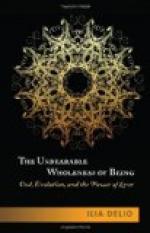But far more interesting than this psychological misunderstanding on the part of the much-lauded sex, is the question as to whether the emotional life of woman matured anything that can be called a worship of man? The answer to this is a decided “no.” At no time in the history of woman do we find even the smallest indication of a parallel phenomenon; the profound and tragic dualism of the Middle Ages—one result of which was the spiritual love of woman—passed her by without touching her. In the feminine soul conflict apparently results not in tragedy and productivity, but in morbidness and hysteria.
It may be argued that the love of Jesus, which inspired both the nuns of the Middle Ages and those of a later period, represents a type of man-worship; but in examining all these more or less famous nuns and ascetics we find, instead of genuine spirituality, a concealed and often morbid condition, which in some cases degenerated into hysteria. The dualistic period, the age of metaphysical love, made no impression upon the female soul. There can be no doubt that the emotional life of woman, in strict contrast to the emotional life of man, has had no evolution, and can therefore have no history. It is unadulterated nature and, in its way, it is perfect.
In studying the female mystics, we find an imitation of metaphysical eroticism sufficiently transparent to be easily recognised, even by the layman, as belonging to the domain of pathology. These ecstatics were animated not by a pure, but by an impure spirit. Perverted sensualists, they believed their hearts to be filled with spiritual love. Contrary to the striving of the greater number of the men, who raised their love into heaven so as to keep it pure, and made it one with their religious aspirations, all the figures and symbols of religion were used by these women as an outlet and a foil to their sexuality. The loving soul repairing to the nuptial chamber is the transparent veil of desire half-concealed by religious conceptions. Women have described similar situations in metaphors which—for sensuous passion—leave nothing to be desired, even the famous love-potion of Tristan is not wanting.
The material is abundant, and I have repeatedly touched upon it in previous chapters. At the period of great mystical enthusiasm (the twelfth and thirteenth centuries) this morbid love of God was a sinister attendant phenomenon of true mysticism. Whole convents were seized by epidemics of hysteria, the women writhed in convulsions, flogged each other, sang hymns day and night and had hallucinations—for all of which the love of God, or the temptation of the devil, were made responsible.
Among the more notable of these pseudo-mystics are Christine Ebner (the author of a book entitled, On the Fullness of Mercy), and Mary of Oignies, a passionate worshipper of Christ who mutilated herself in her ecstasies and who, on her deathbed, still sang: “How beautiful art Thou, oh, my Lord God!”




